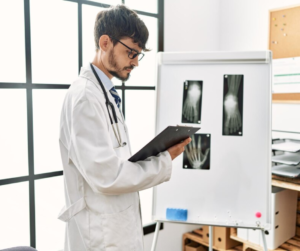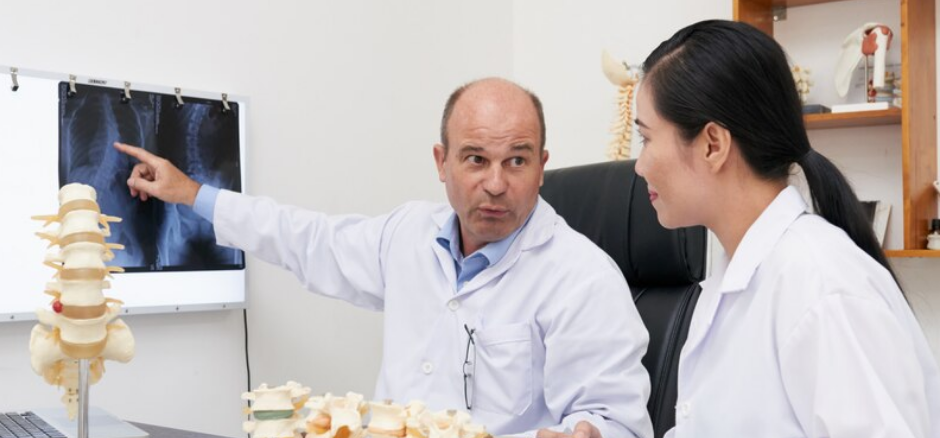What is a bone mineral density test?
A bone mineral density (BMD) test is a medical test that measures the amount of calcium and other minerals in your bones. It’s important because it helps your doctor find out if you have osteoporosis or if you’re at risk of breaking bones.
Osteoporosis is a condition where your bones become weak. It can happen as you get older or due to other factors like not getting enough calcium or vitamin D, not exercising enough, or certain medical conditions.
During a BMD test, you’ll usually lie down on a table while a special machine scans your bones, usually focusing on your hip, spine, or wrist. The machine uses a small amount of radiation, similar to an X-ray, to measure the density of your bones.
Based on the results of the test, your doctor can tell if your bones are healthy and strong, or if you might need treatment to prevent fractures or other complications.
It’s important to get a BMD test if your doctor recommends it, especially if you’re at risk for osteoporosis or if you’ve had a fracture before. Preventing bone loss and fractures can help you stay healthy and active as you get older.
What are some reasons for having a bone density test?
Here are some simple reasons why someone might need a bone density test:
- Checking for Osteoporosis: Doctors use bone density tests to see if you have osteoporosis, a condition where your bones become weak.
- Fracture Risk: If you’ve broken a bone easily before, your doctor might recommend a bone density test to see if you’re at risk for more fractures.
- Monitoring Bone Health: If you have conditions or take medications that can affect your bone strength, like long-term steroid use or thyroid problems, your doctor may want to monitor your bone density over time.
- Menopause: Women who have gone through menopause are at higher risk for osteoporosis due to hormonal changes, so they might have a bone density test to check their bone health.
- Family History: If someone in your family has osteoporosis or has broken bones easily, your doctor might suggest a bone density test to see if you’re at risk too.
Overall, bone density tests help doctors understand how strong your bones are and if there’s a risk of fractures or osteoporosis, so they can recommend treatments to keep your bones healthy.
Types of bone density testing:

Certainly! Here’s a more detailed explanation of dual-energy X-ray absorptiometry (DEXA) bone density testing:
- What is DEXA?
DEXA, or dual-energy X-ray absorptiometry, is a type of bone density test that uses X-ray technology to measure the density of your bones. - How does it work?
During a DEXA scan, you lie down on a table while a special machine passes a low-energy X-ray beam through the bones being examined. A detector measures the amount of X-rays that pass through the bone. This information is used to calculate bone density. - Areas Examined:
DEXA scans typically focus on specific areas of the body where fractures are most likely to occur, such as the hip, spine, or wrist. These areas are commonly affected by osteoporosis.
DEXA scans involve minimal radiation exposure, making them safe for most people. The amount of radiation used is much lower than that of a standard X-ray. - Uses:
DEXA scans are used for diagnosing osteoporosis, assessing fracture risk, and monitoring response to treatment. They are especially important for individuals at higher risk of osteoporosis, such as postmenopausal women and older adults.
Overall, DEXA bone density testing is a valuable tool for assessing bone health, diagnosing osteoporosis, and guiding treatment decisions. It’s safe, accurate, and widely used in clinical practice.
How is the test performed?
Bone tests are performed to assess bone health in various conditions, including:
1. Duration: The bone density test usually takes about 10 to 30 minutes, depending on which parts of your body are being scanned.
2. No Pain or Discomfort: During the test, you won’t feel any pain or discomfort. It’s a simple procedure that doesn’t involve needles or invasive measures.
3. Radiation Safety: The amount of radiation used in a bone density test is very small and considered safe. It’s similar to the amount used in a standard X-ray.
4. Preparation: There’s usually no special preparation needed for a bone density test. You can eat and drink normally beforehand and continue taking your medications unless your doctor advises otherwise.
5. Frequency: How often you need a bone density test depends on age, risk factors, and previous test results. Your doctor will recommend the appropriate schedule for you.
6. Interpreting Results: The results of your bone density test will be given as a T-score, which compares your bone density to that of a healthy young adult. A score above -1 is considered normal; between -1 and -2.5 indicates osteopenia (lower than normal bone density) and -2.5 or lower suggests osteoporosis.
7. Follow-Up: If your bone density is lower than normal, your doctor may recommend lifestyle changes, medications, or other treatments to help strengthen your bones and reduce your risk of fractures.
Bone density testing is an important tool for assessing bone health and preventing fractures, especially as you get older. It’s a routine part of healthcare for many adults, particularly those at higher risk of osteoporosis or fractures.
Conclusion:
In summary, bone density testing is crucial for assessing bone health, especially as individuals age. It is a quick, painless, and safe procedure, requiring minimal preparation and involving minimal radiation exposure. The results, presented as a T-score, guide healthcare providers in recommending appropriate treatments or lifestyle adjustments to maintain bone strength. Regular bone density testing, particularly for older individuals, is essential for preventing fractures and preserving overall health. Additionally, having an X-ray center in Ghatkopar East facilitates convenient access to diagnostic services, enabling timely assessments and interventions for bone health issues within the community.

